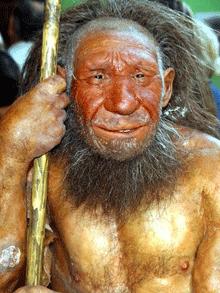I’m battling to keep a cold at bay. I’ve taken on too may shifts back-to-back, not had enough sleep and despite dosing up on vitamin C and germ-killing pills, I’m not convinced it’s having an effect.
Our ancestors on the other hand had an extremely novel way at avoiding illness – having sex with a sub-species to boost their immune system! But I’m not about to go out a shag a primate.
DNA researchers claim that the first modern humans protected themselves against unfamiliar illnesses by interbreeding with Neanderthals which also speeded up modern man’s rapid rise to world dominance.
The research which is due to be published in the journal Science this month says that although it is known that Homo sapiens picked up the disease-resistant genes when they first left Africa, it was unclear until now whether interbreeding played a part in their evolution.
Professor Peter Parham, who carried out the research on human leukocyte antigens (HLAs) – which are vital to the human immune system, is an immunogeneticist at Stanford University School of Medicine, California, he said: “Interbreeding endowed humans with a ‘hybrid vigour’ that helped them colonise the world.”
HLA’s contain some of the most variable genes in the population – known as alleles – which allow the body to react to both established and new diseases.
And while the humans that left Africa probably only carried a small number of the HLA alleles, research indicates that they picked up new ones from the Neanderthals they interbred with as they established themselves in other parts of the world.
Co-author David Reich a population geneticist at the Broad Institute of MIT and Harvard University said: “Neanderthals never lived in China or Papua New Guinea, in the Pacific region of Melanesia, according to the archaeological record. But the fact is that Chinese and Melanesians are as closely related to Neanderthals as Europeans.”
Researchers found that all modern ethnic groups, other than Africans, carry traces (between 1 to 4 per cent) of Neanderthal DNA in their genomes. Although no fossil evidence has been found for Neanderthals and modern humans co-existing in Africa, Neanderthals, like modern humans, are thought to have arisen on the continent.
So how did modern humans with Neanderthal DNA end up in Asia and Melanesia (the island lies north and east of Australia)?
Neanderthals, are believed to have mixed with early Homo sapiens just after they’d left Africa around 60,000 years ago, but before Homo sapiens split into different ethnic groups and scattered around the globe.
Matt Pope, a senior research fellow in the Department for Archaeologist at University College London, said the latest study presented exciting evidence of man’s relationship with his ancestors.
He said: “If modern humans were getting close enough to share DNA, what else were they sharing? Rather than having to evolve from scratch as they moved out of Africa into Europe and Asia, this interaction would have provided a fast-track to new environments.”


Tim Brunt
August 22, 2011
‘Not about to shag a primate’? I hope this article isn’t your way of letting me down lightly!
Tim Brunt
August 22, 2011
I’ll take that as a yes then ;
urbanprimate
August 23, 2011
How very perceptive of you Tim!
A
Tim Brunt
August 23, 2011
(Monkey) Suit yourself then!